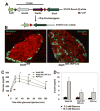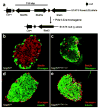The transcription factors Stat5a/b are not required for islet development but modulate pancreatic beta-cell physiology upon aging
- PMID: 17599554
- PMCID: PMC2695665
- DOI: 10.1016/j.bbamcr.2007.05.010
The transcription factors Stat5a/b are not required for islet development but modulate pancreatic beta-cell physiology upon aging
Abstract
In insulinoma cell lines proliferation and insulin gene transcription are stimulated by growth hormone and prolactin, which convey their signals through the transcription factors Stat5a and 5b (referred to as Stat5). However, the contribution of Stat5 to the physiology of beta-cells in vivo could not be assessed directly since Stat5-null mice die perinataly. To explore the physiological role of Stat5 in the mouse, the corresponding gene locus targeted with loxP sites was inactivated in beta-cells using two lines of Cre recombinase expressing transgenic mice. While the RIP-Cre transgene is active in pancreatic beta-cells and the hypothalamus, the Pdx1-Cre transgene is active in precursor cells of the endocrine and exocrine pancreas. Mice carrying two floxed Stat5alleles and a RIP-Cre transgene developed mild obesity, were hyperglycemic and exhibited impaired glucose tolerance. Since RIP-Cre transgenic mice by themselves display some glucose intolerance, the significance of these data is unclear. In contrast, mice, in which the Stat5 locus had been deleted with the Pdx1-Cre transgene, developed functional islets and were glucose tolerant. Mild glucose intolerance occurred with age. We conclude that Stat5 is not essential for islet development but may modulate beta-cell function.
Figures



References
-
- Brelje T, Scharp D, Lacy P, Ogren L, Talamantes F, Robertson M, Friesen H, Sorenson R. Effect of homologous placental lactogens, prolactins, and growth hormones on islet B-cell division and insulin secretion in rat, mouse, and human islets: implication for placental lactogen regulation of islet function during pregnancy. Endocrinology. 1993;132:879–887. - PubMed
-
- Nielsen J, Galsgaard E, Moldrup A, Friedrichsen B, Billestrup N, Hansen J, Lee Y, Carlsson C. Regulation of beta-cell mass by hormones and growth factors. Diabetes. 2001;50:S25–29. - PubMed
-
- Nielsen J, Svensson C, Galsgaard E, Moldrup A, Billestrup N. Beta cell proliferation and growth factors. J Mol Med. 1999;77:62–66. - PubMed
-
- Galsgaard E, Gouilleux F, Groner B, Serup P, Nielsen J, Billestrup N. Identification of a growth hormone-responsive STAT5-binding element in the rat insulin 1 gene. Mol Endocrinol. 1996;10:652–660. - PubMed
-
- Goffin V, Kelly P. The prolactin/growth hormone receptor family: structure/function relationships. J Mammary Gland Biol Neoplasia. 1997;2:7–17. - PubMed
Publication types
MeSH terms
Substances
Grants and funding
LinkOut - more resources
Full Text Sources
Medical
Molecular Biology Databases
Miscellaneous

